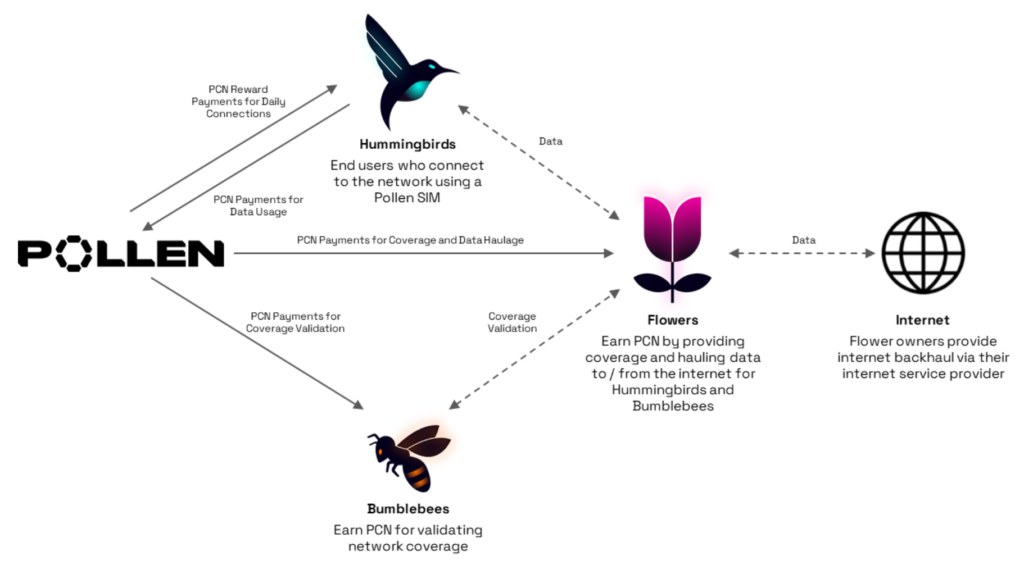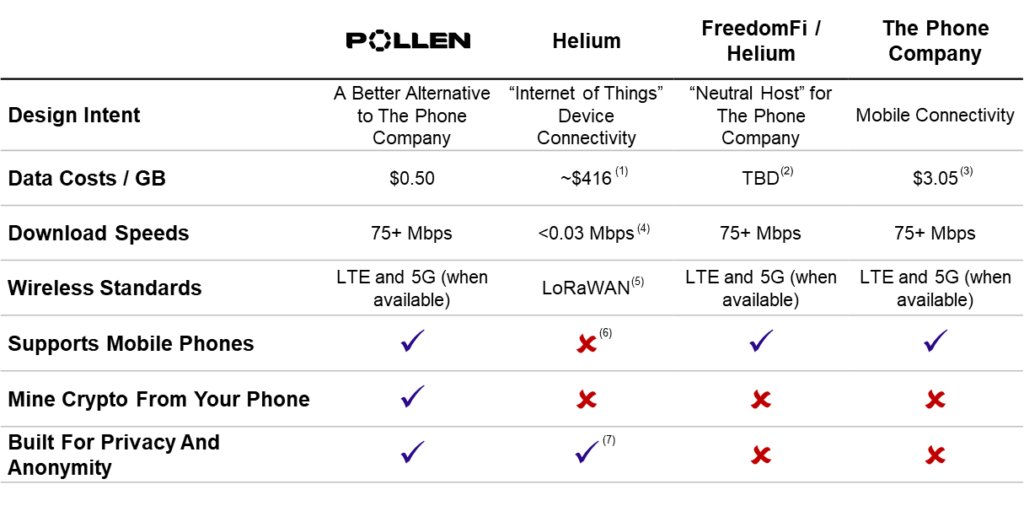According to their website, Pollen Mobile is “the world’s first decentralized mobile network that’s built on the blockchain and owned and operated by its users.”
The project is fairly new — their whitepaper was just published in January 2022.
Pollen was started by Pronto, a San-Francisco-based company that develops autonomous driving technology for off-road applications (e.g. trucks in the mining industry). The trucks needed mobile connectivity to work, but because mines are usually in areas without reliable or affordable cell coverage.
Then, thanks to FCC changes to CBRS in 2020, Pronto was able to build its own cell towers and their own mini-mobile networks to connect their autonomous vehicles.
This led them to spin off the mobile-network building part of the operation into Pollen Mobile.
Pollen is currently active in San Francisco, with expansion to New York and Los Angeles underway as of March 2022.
How does Pollen Mobile work?
Pollen doesn’t use cell data; it’s a data-only network. You can still make “phone calls” on the network but they have to go through something like FaceTime or another purely-data-based call app. You can’t send traditional SMS text messages, but you can send messages through Signal, WhatsApp, Telegram, and other similar messaging apps.1
The advantages of a data-only network are security and privacy. Data can be encrypted (if you use encrypted apps like Signal), but cell data cannot be:
“We are building a “data-only” mobile network because legacy concepts such as “phone calls” and “text messaging” are inherently insecure, incompatible with our Core Values, as outlined below, and can be replicated with applications such as Signal, iMessage, FaceTime, and WhatsApp, which are compatible.”
— Pollen Whitepaper 0.0.1
Data will be transmitted using CBRS (aka Citizens Broadband Radio Service) spectrum in the US, which is open for anyone to use (as far as I know). You won’t need a license to use the network or carry data through a Pollen Device.
The Pollen Ecosystem: Flowers, Bumblebees, and Hummingbirds
The Pollen ecosystem runs on three types of hardware: Flowers, Bumblebees, and Hummingbirds.

Flowers
Flowers are antennas that wirelessly transfer data between your ISP and the users of the Pollen network.
Flowers range in size from small devices (like a Dandelion) that can be placed on your roof or suction-cupped to your window, to large six-foot towers (like a Buttercup) that you can place on your roof or perhaps a nearby hilltop.2
Flowers are mobile network antennas that are connect to your home or business internet connection. When Pollen-enabled devices (i.e. a cell phone with a special Pollen eSIM) connect to a flower, the Flower is rewarded for connecting the Hummingbird to the internet and hauling data to the user’s phone.
I like that Pollen does seem to be really serious about privacy and is also building a company in a crypto native way — Pollen doesn’t store personal information of flower owners — instead the ownership rights are registered via an NFT that will live in the owner’s Solana wallet, providing anonymity for the Flower provider.
Bumblebees
Bumblebees are small, portable devices that validate the Pollen network. They come with built-in LTE connectivity and GPS antennas. They validate network coverage by reporting network coverage statistics as they move through the physical world.3
Bumblebees collect metadata (not network throughput data) from Flowers, including signal strength, internet connection speed, and GPS location.
For people familiar with Helium, the Bumblebee concept may be a bit new. Helium miners carry data and do proof of coverage while Pollen has a separate validating device.
In other words, Bumbebees do the proof of coverage work for the network.
You carry a Bumblebee with you as you move around in your day-to-day life, driving your car or riding your bike, or just walking around, and you get rewarded whenever your Bumblebee connects to a Flower.
Like Flowers, Pollen does not track personal information of Bumblebee owners, and ownership is registered via a Solana NFT.
Hummingbirds
A Hummingbird is basically an eSIM that you can use to connect your cellphone to the network.
I’m new to this so I’m not sure exactly how eSIMs work yet, but I’ll be testing it out when I get my first batch of devices.
My understanding now is that an eSIM allows you to connect to a second mobile network without changing the physical SIM card in your phone. So your main SIM can connect to Verizon, AT&T, or some other provider while the eSIM allows you to also connect to the Pollen network when in range of a Flower.4
Eventually, Hummingbird users will have to pay for the data they use (at $0.50 per gigabyte), but in this initial phase, Hummingbirds will get free data and earn PCN tokens for connecting, as a way to incentivize end users to start using the network.
And $0.50 per gigabyte is really cheap for data (my current provider, Google Fi, charges $10/gig).
What about phone numbers?
There’s no plan to offer Pollen phone numbers, but users can still obtain a number without a legacy phone plan through a service like Google Voice or purchasing a prepaid burner phone.5
How much does the hardware cost?
The most recent device sale on March 9, 2022 offered three packages. Each package included one Flower, one Bumblebee, and five Hummingbirds (to hand out to friends).
Prices ranged from $1,299 for the a Dandelion (an indoor Flower) package to $5,999 for a Buttercup (a large, long-range Flower) package.
Those prices were higher than earlier sales, and in this last sale, all 150 units sold out in less than fifteen minutes, so we may see prices go up as demand is quite high right now.
How is Pollen different from Helium and FreedomFi?
Your phone can connect directly to the Pollen network with a Pollen SIM (or eSIM). It’s like Verizon, AT&T, etc. only at a lower cost and with privacy and anonymity.
With Helium + FreedomFi, your phone can connect to the Helium 5G network, but only through a participating telco like DISH or GigSky (although other major telcos will probably jump on board soon, TBD).
Here’s a comparison chart for context:

How much money can you earn with Pollen?
OK, the part that you probably care the most about — how much money can you make money with this?
First, some very basic tokenomics.
The $PCN Token
Pollen Coin ($PCN) is a Solana-based token with s a fixed supply of 1 billion:
- 500 million PCN are allocated to incentive payments, paid out daily to incentivize the network growth over the next ten years.
- 200 million go to a Sponsor Pool.
- 150 million to an Investor Pool.
- And the final 150 million go to an Ecosystem Fund “earmarked for teams/partners providing critical services to the network.”
The token is live, but it’s not publicly listed on any exchanges (be careful — there are some other tokens with the same PCN symbol out there).
Right now, 300,000 PCN are distributed each day to network participants. That amount will slowly decrease over the course of the next ten years.
No, seriously, how much can you earn?
Well right now, if you’re not in SF, LA, or NY, then the answer is 0.
But for device-owners in those cities, let’s look at some numbers.
There are three ways to earn PCN – by setting up a Flower, carrying a Bumblebee with you, and using a Hummingbird eSIM on your phone.
We can look at the Pollen Explorer to see what some devices are currently earning in San Francisco. I haven’t done a systematic survey but on average, it looks like Camellia flowers are earning about 1,800 PCN per day and Buttercups are earning about 2,500 PCN per day.
These numbers vary widely and the top devices are earning way above the average: yesterday, the top Camellia earned 22k PCN, the top Dandelion earned 17k PCN, and the top Buttercup earned 13k PCN.
And Bumblebees seem to be averaging around 250 PCN per day (there’s less variance with Bumblebees; yesterday’s top performer earned 1,067 PCN).
Now, to calculate the earnings, we need to know the price of PCN. The token isn’t trading on any exchanges yet so we don’t know what the price will be in a public liquid market. But, there’s an OTC trading group on Telegram and as of yesterday there was at least one buyer willing to buy 100k PCN at a price of $0.25.
That translates to:
- A Camellia earning 1,800 PCN/day, that would be roughly $450 per day.
- A Buttercup earning 2,500/day would net you around $625/day.
- A Bumblebee earning 250 PCN/day would net you ~$62.50/day.
Some (major) considerations
Before you liquidate your childrens’ college fund to buy as many Flowers as you can get your hands on, let us consider that caveats abound.
First of all, the current daily earnings are being split among a very small number of devices in SF. As more devices come online, the earnings pie will be distributed among an increasingly large number of devices.
Second, PCN emissions will decrease over the next ten years, with regular halvings until the incentive supply is depleted.
Third, earnings are highly location-dependent.
Fourth, the price of PCN may go down. We have no idea what will happen when there’s a liquid market. Presumably most participants are holding their earned PCN. Some of them will want to sell when the token gets listed, which could drive the price down. Eventually, as the network grows with real users, the value of PCN should increase, but that may be years away.
All that being said, it seems pretty clear that in today’s conditions which will almost certainly change soon, a single Flower can be quite lucrative.
I bought my first Flowers yesterday and I’m excited to see how they work once I deploy them in Los Angeles. That was a sizeable up-front investment in an unproven technology, but for me, the upside justifies the risk.
And look, apart from making money, which *cards on the table* is something I very much enjoy, there are some truly compelling reasons to participate in Pollen, like helping to bootstrap a national (and perhaps someday global) decentralized, private, and secure data network for consumers.
Pretty cool stuff.
Resources and further reading
I’m curious about is how this will work for the end user — do you have to switch networks back and forth to place a traditional call? Can I route all of my phone’s data through Pollen while continuing to receive SMS and calls? I’m guessing that Pollen is hoping to eventually be big enough to obviate the need for traditional cell networks, but that’s a few years off. ↩
For being a company focused mainly on autonomous industrial vehicles, they sure do a have a playful side when it comes to naming. You get the feeling that they’re having fun with all of this. ↩
It’s not clear to me if Bumblebees can also transfer data. The whitepaper says “In the initial phase of the network’s deployment, Bumblebees will be able to connect to the network and transfer data for free – in Phase II, Bumblebee owners will need to purchase Data Credits using PCN for connectivity and data transfer” but I can’t find any information on this. ↩
I’m especially curious about how automated this is — does your phone switch back and forth automatically? We’re a long ways away from Pollen’s coverage being robust enough to completely replace your existing cell provider, so the mechanics of this will be important for spurring adoption. I’ll write about this more in future posts. ↩
For more on what it means to have a mobile network that isn’t tied to phone numbers, see Why Is Pollen a Data-Only Network? ↩